1. Pain on the lateral or side of the shoulder is gradual.
2. No significant traumatic event.
3. Pain prevents you from falling asleep at night.
4. Overhead and activity behind the back is difficult and painful.
5. Use of NSAIDS does not help with pain reduction.
Five Signs that You Have Traumatic Rotator Cuff Tear
1. A pop occurs with the use of the shoulder.
2. After the pop is felt or heard, you are unable to fully lift your shoulder.
3. Night pain that makes it difficult to fall asleep.
4. Pain that is located over the outer side of the shoulder.
5. Activities such as putting your arm behind tour back are difficult and painful.
Bilateral Distal Radius Fractures
This is not a good result after a successful dunk of the basketball. Good news is that they were non displaced and short arm casts were applied. What has been your worst broken bone experience?

Gout vs. Pseudogout Comparison
1. Gout is the deposition of uric acid crystals.
2. Pseudo gout is the deposition of calcium pyrophosphate dihydrate crystals.
3. Both conditions produce sharp crystals which are extremely painful. Think of it as throwing a bunch of broken glass into your joint. That’s what happens with gout and pseudogout.
4. Gout may occur with a diet that is rich in meat while Pseudogout has no precipitating factors.
5. Gout is treated with a medication called colchicine for acute events and a medication called allopurinol for long-term preventive treatment. Pseudogout is typically treated with a steroid acutely and there is no long-term prevention medication treatment recommended.
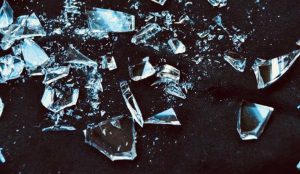
Why is it bad to smoke when you have a broken or fractured bone?
Nicotine is very toxic to your body. Cigarettes can have up to 3,500 different toxins in addition to nicotine.
Nicotine causes vasoconstriction. The “vaso” is Latin for blood vessel and “constriction” means to get smaller. When you are using nicotine or are even around other people that are smoking and have third hand smoke on your clothes that can cause your blood vessels to undergo vasoconstriction. The result is less blood being delivered to the area where the fracture has occurred. The blood flow is very important to help heal the fracture.
Vaping is just as bad as smoking if you are vaping with a product that has nicotine.
Studies have shown that if you are consuming nicotine you can increase the time to heal the fracture by double and sometimes a fracture will just not heal. In that case, you will need to undergo surgery to get the broken bone to heal. Most surgeons will require you to stop smoking before they would undergo surgery to help heal a bone that has not healed because of nicotine intake.
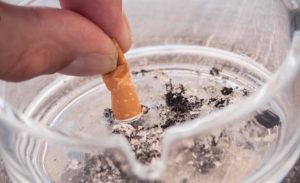
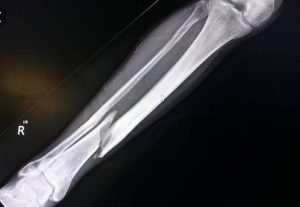
An ACL Injury
What you need to know after the injury has occurred:
1. 81% of individuals of all ages return back to sports after ACL reconstruction.
2. 65% will return to the same level of play.
3. Psychosocial factors may play a role in determining who returns back to sports.
4. There is as much as a 40% chance you will tear your ACL in your other knee (the contralateral side).
5. There is an 85% chance within 5 to 10 years of tearing your ACL that you will start experiencing signs of early osteoarthritis in the same knee.
6. There is no difference in the amount of arthritis in a knee with a torn ACL whether the knee underwent ACL surgery or the patient elected not to have an ACL reconstruction.
7. There is an increased risk of further injury to the same knee. Up to 19% of the time a second knee surgery is needed in the knee that had an ACL injury.
8. Up to 8% of the patients undergoing an ACL reconstruction will re-tear their graft. Risk factors for graft failure include younger age, female gender, higher activity level and the use of a cadaver graft to reconstruct the ligament.
9. Patients with a history of an ACL injury have a higher incidence of undergoing knee replacement surgery in the future (up to seven times more than age matched cohorts).

Where is the fracture?
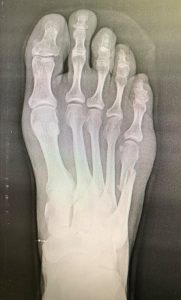

Fifth Metatarsal Fracture
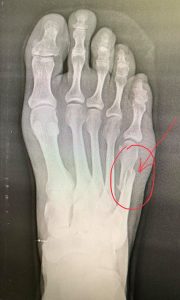
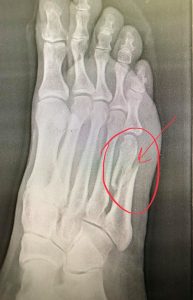
Why Does Weight Loss Help Arthritic Knees?
For every step you take while walking, 3 pounds of force is applied on your knee joint. So for example, if you weigh 100 pounds, when you walk, every step places 300 pounds of force on your knee joint.
When you ride a bicycle you apply 3 pounds of force on your knee joint. Running places 10 pounds of force for every pound that you weigh on your knee joint. So that 100 pound person actually puts 1,000 pounds of force with every step they take while running.
If you are a runner and you have arthritic knees you should consider cross training for some of your run days. Running will just accelerate the arthritic process because of the amount of force being applied to the knee joint that already is unhealthy.
If you have arthritic knees and you are overweight, it will definitely help to lose weight. I get asked all the time from my patients, “How I am supposed to lose weight if I can’t exercise.”
Science has proven that most weight loss occurs through reduction of caloric intake and not through exercise.
I’d like to give the example if you can run an eight minute mile, which is pretty quick, you only burn about 87 calories. That is about half a piece of bread. So if you restrict your caloric intake, you will reduce your total calories quicker than with exercise. You would have to run about 4 miles, at an eight minute pace, to burn enough calories to eat a piece of chocolate cake. If you don’t eat the chocolate cake you are ahead by 4 miles so to speak without ever even going to the gym.
I like the saying that you lose weight in the kitchen and get fit in the gym. Daily exercise is extremely important. However, exercise is not the quickest way to achieve weight loss. It is important if you have arthritic knees to choose exercise that gives you a good cardio workout, keeps your muscles strong but does not put excessive amount of force on your knee joints.
So for every pound you can lose, you are helping to save your knee joints.
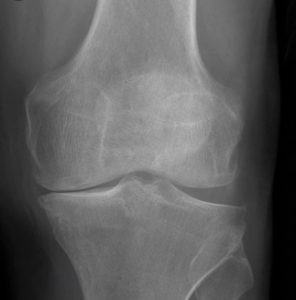

4 Cortisone Injection Myths
1. Cortisone causes knee osteoarthritis.
This is not true. The reason you’re doctor is recommending a cortisone injection is because your knee is arthritic.
2. A cortisone injection into a knee or shoulder joint will make me fat.
This is also not the case. There is a slight systemic affect when you were given a cortisone injection into a knee or other joint. It may raise your appetite for 1 to 2 days after the injection. You need to consume an excess of 3,500 calories over your normal amount of what you eat per day to gain a pound of weight. A potential slight increase in appetite over one to two days will not cause you to gain weight.
3. Cortisone will deteriorate my bones.
Cortisone injections given into a joint will not deteriorate your bones. If you take oral prednisone (which is a pill form of cortisone) for more than three months in a row, the prednisone can cause osteopenia. Osteopenia is a condition when bones lose their strength. However, a cortisone injection into a joint will not cause osteopenia.
4. You can only get three or four cortisone injections in your lifetime.
You can get cortisone injections every three months in a joint. The rate limiting factor is the fact that cortisone stops being effective if given in intervals closer than three months. There is not an absolute number of cortisone injections you can get during your lifetime. Eventually as the arthritis worsens the cortisone becomes less effective.
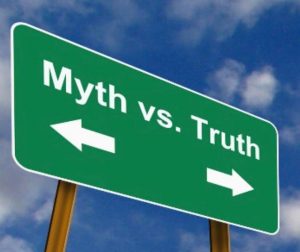
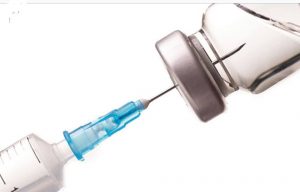
Ortho Bone Slang
– Heel bone / calcaneus
– Collar bone / clavicle
– Shin bone / tibia
– Knee cap / patella
– Funny bone / ulna
– Back bone/ lumbar vertebrae body
– Sit bones / ischial tuberosity
– Thigh / femur
– Knuckles / metacarpal phalange joints
– Breast bone / sternum
– Ankle / tibial talar joint
– Hip joint / acetabulum
– Tail bone / coccyx
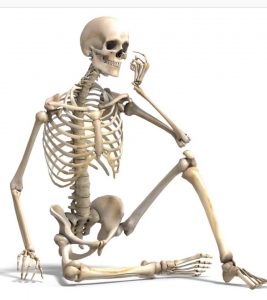

Recent Comments